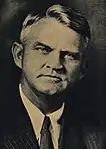1912 United States Senate elections in Arizona
The 1912 United States Senate elections in Arizona took place in the Arizona State Legislature on March 27, 1912, confirming the selection of Marcus A. Smith and Henry F. Ashurst as the state's first U.S. Senators.[1] Their results were pre-determined on the basis on the results of a popular vote taken on December 12, 1911.
This marked the first U.S. Senate elections held in the state after it was admitted to the union as the 48th state on February 14, 1912. The two men were sworn in on April 2.[2]
The Seventeenth Amendment to the United States Constitution established the direct election of United States senators in each state. The amendment supersedes Article I, §3, Clauses 1 and 2 of the Constitution, under which senators were elected by state legislatures. The amendment was proposed by the 62nd Congress in 1912 and became part of the Constitution on April 8, 1913, on ratification by three-quarters (36) of the state legislatures.
Class 1
| |||||||||||||||||||||||||
| |||||||||||||||||||||||||
| |||||||||||||||||||||||||
Henry F. Ashurst was elected to the Territorial House of Representatives in 1897. He was re-elected in 1899, and became the territory's youngest speaker. In 1902, he was elected to the Territorial Senate. In 1911, Ashurst presided over Arizona's constitutional convention.[3] During the convention, he positioned himself for a U.S. Senate seat by avoiding the political fighting over various clauses in the constitution which damaged his rivals.[4]
| Party | Candidate | Votes | % | ||
|---|---|---|---|---|---|
| Democratic | Henry F. Ashurst | 10,872 | 50.00% | ||
| Republican | Ralph H. Cameron | 9,640 | 44.33% | ||
| Socialist | E. Johnson | 1,234 | 5.68% | ||
| Majority | 1,232 | 5.67% | |||
| Turnout | 21,746 | ||||
| Democratic win (new seat) | |||||
Class 3
| |||||||||||||||||||||||||
| |||||||||||||||||||||||||
| |||||||||||||||||||||||||
| Elections in Arizona |
|---|
 |
Marcus A. Smith announced his candidacy for one of Arizona's two senate seats on September 24, 1911.[6] As the campaign began, Smith abandoned his long standing conservative stand and declared himself a "Progressive".[7]
| Party | Candidate | Votes | % | ||
|---|---|---|---|---|---|
| Democratic | Marcus A. Smith | 10,598 | 50.35% | ||
| Republican | Hoval A. Smith | 9,228 | 43.85% | ||
| Socialist | E. B. Simonton | 1,221 | 5.80% | ||
| Majority | 1,370 | 6.50% | |||
| Turnout | 21,047 | ||||
| Democratic win (new seat) | |||||
See also
References
- Goff 1989, p. 60.
- "Senate Now Numbers 96". New York Times. April 3, 1912.
- "Henry Fountain Ashurst Dead; Former Senator from Arizona". New York Times. June 1, 1962. p. 27.
- Johnston, Alva (December 25, 1937). "The Dean of Inconsistency". The Saturday Evening Post. 210: 23, 38–40.
- "Our Campaigns - AZ US Senate Race - Mar 27, 1912".
- Fazio 1970, p. 55.
- Goff 1985, p. 145.
- "Our Campaigns - AZ US Senate Race - Dec 12, 1911".
Sources
- Fazio, Steven A. (Spring 1970). "Marcus Aurelius Smith: Arizona Delegate and Senator". Arizona and the West. 12 (1): 23–62. JSTOR 40168029.
- Goff, John S. (1985). Arizona Territorial Officials Volume III: The Delegates to Congress 1863-1912. Cave Creek, Arizona: Black Mountain Press. OCLC 12559708.
- Goff, John S. (1989). Marcus A. Smith. Arizona biographical series. Vol. v. 5. Cave Creek, Arizona: Black Mountain Press. OCLC 21013345.




